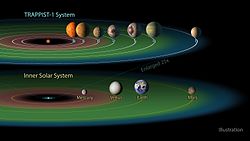User:ChyranandChloe/Workshop 1
Currently hosting 6,994,668 articles in English.
Site news • Village pump • Community portal
 Habitable zones of TRAPPIST-1 and the Solar System TRAPPIST-1 is a cool red dwarf star with seven known exoplanets. It lies in the constellation Aquarius about 40.66 light-years away from Earth. It has a mass of about 9% of the Sun and is estimated to be 7.6 billion years old, making it older than the Solar System. The discovery of the star was first published in 2000. Observations in 2016 from the Transiting Planets and Planetesimals Small Telescope (TRAPPIST) led to the discovery of two orbiting terrestrial planets, and five more were found in 2017. It takes the seven planets between about 1.5 and 19 days to orbit around the star. They are likely tidally locked to TRAPPIST-1, leading to permanent day on one side and night on the other. Their masses are comparable to that of Earth. Up to four of the planets orbit at distances where temperatures are suitable for the existence of liquid water (diagram pictured), and are thus potentially hospitable to life. This has drawn interest from both researchers and popular culture. (Full article...)
Recently featured:
|
 Bertoncelj at the 2015 European Games
|
|
|
May 17: International Day Against Homophobia, Biphobia and Transphobia
|
|
The short-beaked echidna (Tachyglossus aculeatus) is one of four living species of echidna. It is covered in fur and spines, has a distinctive snout to help detect its surroundings, and uses a specialized tongue to catch insects. Its extremely strong front limbs and claws allow it to burrow quickly. It repels predators by curling into a ball and deters them with its spines. During the Australian winter, it goes into deep torpor and hibernation. As the temperature increases, it emerges to mate. Female echidnas lay one egg a year and the mating period is the only time the solitary animals meet. A newborn echidna grows rapidly on mother's milk and is expelled into the mother's burrow when it grows too large for the pouch. It leaves the burrow when it is around six months old. The species is found throughout Australia and in coastal and highland regions of eastern New Guinea. It is not threatened with extinction, but human activities have reduced its distribution in Australia. This photograph shows a Tasmanian short-beaked echidna (T. a. setosus), a subspecies of the short-beaked echidna, near Scottsdale, Tasmania. Photograph credit: Charles J. Sharp Recently featured: Margaret Hamilton - Kiwifruit - Lysander Spooner |
| Commons Free media repository | |
| Wiktionary Etymology, dictionary, and thesaurus | |
| Wikisource Free-content library | |
| Wikinews Free-content news | |
| Wikibooks Free textbooks and manuals | |
| Wikiquote Collection of quotations | |
| Wikispecies Directory of species | |
| Meta-Wiki Wikimedia project coordination | |
| Wikiversity Free learning materials and activities |
English · Deutsch (German) · Français (French) · Polski (Polish) · 日本語 (Japanese) · Italiano (Italian) · Neerlandés (Nederlands) · Português (Portugese) · Español (Spanish) · Русский (Russian) · Svenska (Swedish) · 中文 (Chinese) · Bokmål (Norsk) · Suomi (Finnish) · Català (Castillian)













